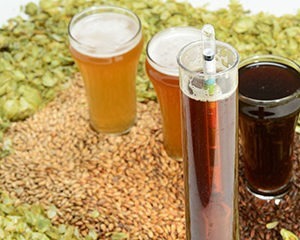Prepping For A Homebrew Competition

Entering your homebrew into a competition can result in unforeseen advantages other than just winning some hardware. Judges provide feedback that can lead to changes in your brewing protocol, which can lead to big advancements in your beer quality. But in order to get the best feedback possible, homebrewers looking to enter a competition need to avoid certain pitfalls so that their beer is presented to judges in top form.
Recipe Design
First off, you’re going to want to brew for your audience. That Kölsch that scored high in a competition sanctioned by the BJCP (Beer Judge Certification Program), may not win many accolades at the local street fest homebrew competition where a trendy beer style may be more admired by the judges.
If you are serious about entering in a BJCP-sanctioned competition, then there are a few resources that will greatly help in the recipe design element. Your first resource should probably be the BJCP Style Guidelines. After that, three books that stand out to me are: Designing Great Beers by Randy Mosher, Brewing Classic Styles by Jamil Zainasheff and John Palmer, and Gordon Strong’s Modern Homebrew Recipes. They are all great resources. Also, through the years both Jamil Zainasheff and Gordon Strong have done an amazing job outlining recipe development across a huge range of style in BYO’s “Style Profile” column. Digital members here at byo.com have access to nearly all of them at their fingertips.
Ingredients and Brew Day
Procuring fresh ingredients is a big part of producing a top-quality brew. Now is not the time to use up that old bag of crystal malt that’s been sitting in your grain bin since . . . huh, you’re not actually sure when. And if you’ve had success with a certain base malt, now may not be the time to decide to “upgrade” to a more expensive type. I say to stick with what you know; go with the hops, malts, yeast, and water profiles that have worked for you. This could be said for most of your ingredients.
Just like with ingredients, now is not the time to experiment with new techniques. This can add an undue stress on your brew day that may lead to mistakes. Go with what you know and whatever you do, no knee-jerk reactions if something goes a little off the tracks.
Also, I do advise keeping some sugar and dried malt extract on hand just in case your gravity comes in under where it should be. Brewing a double IPA only to find a gravity of 1.059 at the end of the boil can really take the wind out of your sails. A sugar and/or extract addition can remedy that quickly.
Finally, for many styles a yeast nutrient addition along with a kettle-fining agent should be employed. Both of these products will give you the best chance of both a strong and healthy fermentation and quality appearance.
Fermentation
While I generally understress brew days, I do stress fermentation control. Pitching an appropriate level of yeast should be the first area of focus. Using an online yeast-pitching calculator is especially helpful when using a liquid yeast strain and be sure your dried yeast is not out of date. In general, lagers should get roughly double the pitch rate compared to ales.
Temperature control is the next focal point. Those with advanced glycol systems have a definite advantage in this arena. But temperature control via enclosure, such as a refrigerator with an external thermostat, is equally beneficial. Having a temperature-stable room can also work, but not having the ability to adjust the fermentation temperature can be a drawback. Also, it’s never a bad thing to raise the temperature several degrees near the end of fermentation to assure the yeast finishes cleaning up the byproducts of active fermentation.
Packaging Time
If the competition is a local street fest, then packaging your homebrew can often come in the form of bottle, can, or keg. Even if you keg your beer, you can still bottle or can the beer in order to avoid the hassle of bringing a whole draft system along. A counter-pressure filler or BeerGun® type of filler would be your best options for filling. When filling with a BeerGun®, make sure you cap on foam (meaning the foam is above the level where the cap sits) and bump up the beer’s carbonation level by about 0.2 volumes as some will be lost during the bottling process.
If you are sending in your beer for judging, then you need to bottle or can the beer. Bottle conditioning your beer will be required if you don’t have a kegging system. Give the yeast an extended time to assure full carbonation.
Entry and Shipping
Your final touch points revolve around entry category selection, packaging, and shipping (if needed). A local drop-off would be preferred if the competition entry deadline is either in summer or winter where excessive heat or freezing may pose an issue. Be sure to choose the correct category and be descriptive so judges aren’t left guessing, especially when entering beers in the specialty beers category.
Finally, even if you thought your beer was amazing but the judges dinged it, try to use their feedback constructively. Sometimes it truly is the luck of the draw, what time of day your beer was judged, what beers were judged with it, the mood of the judging group . . . there are so many x-factors. Don’t let a bad score ruin your day.


